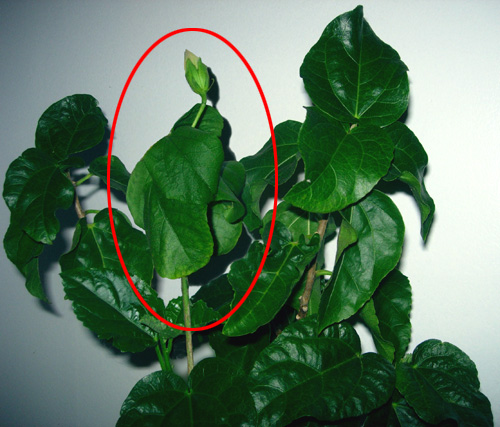Hibiscus Plant Care
Hibiscus Dieback Disease
All the Leaves on One Branch of my Hibsicus are Wilting!
 Dieback Disease One Wilted Branch on an Otherwise Healthy Hibiscus |
Causes of Dieback Disease
This disease is usually caused by a break in the bark of the stem that allows fungi or bacteria to enter. This break can be from pruning, insect damage, or just a natural occurrence from something striking or rubbing against the stem. Fungus and bacteria can enter the stem at the point of the break in the bark, and start rotting the stem at that point.
Another common cause is a spent flower that does not fall completely off the plant. If a hibiscus bloom is trapped by leaves and stems from falling, and instead remains in contact with a stem, it can cause the stem to rot. This happens much more often in the cool wetness of fall and winter when fungus such as Botrytis are active. Hibiscus blooms naturally dry out and wither away if the humidity is low, but if the humidity is high, they can rot as fungus and/or bacteria consume them. The wet rot of of a bloom that is trapped against a stem will sometimes pass the infection on to the stem and the stem begins to rot at the point of contact.
Less common but possible, is for the fungus or bacteria infection to start in the flower, spread to the flower stem (peduncle), and then travel through the peduncle to the main stem that it is attached to. This will also cause a rot to start at the point where the peduncle attaches to the stem.
In all the above cases the rot begins at one point on one stem and is not systemic to the whole plant. Sometimes the hibiscus can stop the rot and prevent it from spreading beyond the original point, but at other times the rot slowly spreads along the stem. When the spread damages the inner tissues that carry water upward the leaves above the damaged area will wilt. If left untreated, the disease may spread to other stems and even the entire plant. If that happens the plant will usually die.
Another form of dieback can occur from internal infections of the plant similar to those that cause Wilt Disease. In the case of Dieback, the fungi or bacteria (Erwinia sp mostly) do not block the circulation of nutrients enough to cause wilt but instead accumulate at the very tips of the stems where they will sometimes appear to explode out of the top of the branch. Instead of wilted leaves you see the damage that starts at the tip of the stem and spreads down the stem. No leaves grow from the damaged area at the top of stems and the area takes on a damaged appearance, much different from a healthy stem. This makes the disease easy to spot.
How to Treat Dieback Disease
 Tip Dieback Two Healthy Side Branches, Two Dying Tips |
Cut away the infected part of the stem(s) from the plant. Find the source of the infection, which will appear as a discolored area on the stem. Often there is wilting of leaves immediately above the infected area. Go down the stem one or two nodes and then cut the stem 1/4 inch above the node, removing the infected area. Dispose of the bad wood in the trash, not on the ground.
Next, look at your final cut. The inner core of the wood should look clean and white. If there is dark streaking visible, it is best to go a few more inches down the stem and cut again. Keep doing this until clean wood is found.
Apply grafting wax or sterile canning wax to your final cut to seal the cut and to prevent re-infection thru the cut. Alternatively, painting the wound with Phyton (Copper biocide) diluted to label-specified strength is a good idea, too.
Prevention of Dieback Disease
The following are good hygiene practices that will help in the prevention of Dieback Disease:
Remove all spent blooms from the plants.
Prune away branches that are accidentally broken but are still hanging on to the plant.
Remove the peduncle that was holding the flower by cutting it close to the stem it attaches to. Do this carefully so as not to create a wound in the side of the stem.
Provide good air circulation with fans or plenty of vents if indoors.
Wet conditions will contribute to the problem. Water early in the day so plants dry out before nightfall.
Keep dead wood pruned off your hibiscus plants. To tell if wood is dead, scratch the surface with a fingernail. If the wood under the bark is bright green, it is still alive. If it is any other color, it is dead.
Use smart growing practices, such as keeping the area clean and weed free, and controlling insects.
Promote a healthy soil using worm castings and/or beneficial fungi.